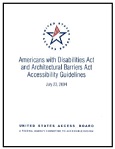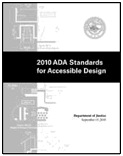ADA Accessibility Standards

DOJ’s and DOT’s ADA Standards are based on the Board’s ADA Accessibility Guidelines (2004).
Both DOJ’s and DOT’s ADA Standards are based on minimum accessibility guidelines adopted by the Access Board in 2004, known as the ADA Accessibility Guidelines. As a result, these two sets of standards are very similar for the most part. However, each contains additional requirements that are specific to the facilities covered by the respective agencies.
DOJ’s 2010 ADA Standards for Accessible Design
DOJ’s 2010 ADA Standards for Accessible Design became effective March 15, 2012 and apply to all facilities covered by the ADA except public transit facilities. This includes state and local government facilities subject to title II and places of public accommodation and commercial facilities under title III.
As implemented under title II, the 2010 Standards consist of the regulatory provisions in 28 CFR §35.151 and appropriate sections of the Access Board’s 2004 ADA Accessibility Guidelines (36 CFR part 1191, appendices B and D).
For title III of the ADA, the 2010 Standards consist of both the regulatory provisions in 28 CFR part 36, subpart D, and appropriate sections of the Access Board’s 2004 ADA Accessibility Guidelines (36 CFR part 1191, appendices B and D).
DOJ’s 2010 ADA Standards are available on DOJ’s ADA website at http://www.ada.gov/.
DOJ’s 2010 Standards include provisions not included in DOT’s standards that supplement or modify requirements related to scoping for:
-
assembly areas (§221)
-
medical care facilities (§223)
-
transient lodging, including housing at places of education (§224)
-
detention and correctional facilities (§232)
-
social service establishments (§233)
-
housing provided by state or local governments for sale to individual owners (§233).
DOT’s ADA Standards (2006)
DOT’s ADA Standards apply to facilities used by state and local governments to provide designated public transportation and to commuter and intercity rail stations. The current edition of the standards applies to new construction and alterations undertaken after November 29, 2006. These standards are very similar to DOJ’s 2010 Standards but include unique provisions concerning:
-
accessible route location (§206.3)
-
detectable warnings on curb ramps (§406.8)
-
bus boarding and alighting areas (§810.2.2)
-
rail station platform (§810.5.3).
How the ADA Standards are Enforced
DOJ’s and DOT’s ADA Standards are not a building code, nor are they enforced like one. They constitute design and construction requirements issued under a civil rights law. The ADA’s mandates, including the accessibility standards, are enforced through investigations of complaints filed with federal agencies, or through litigation brought by private individuals or the federal government. There is no plan review or permitting process under the ADA. Nor are building departments required or authorized by the ADA to enforce the ADA Standards (some building departments even include a disclaimer on their plan checks indicating that ADA compliance is not part of their approval process). Entities covered by the law ultimately are responsible for ensuring compliance with the ADA Standards in new construction and alterations.
State and Local Access Codes
Building design and construction, including safety and accessibility, is largely regulated and enforced by states and local jurisdictions. The ADA does not intrude upon the authority these governmental entities have traditionally exercised over the built environment. Most states and many local jurisdictions have laws or ordinances that address access to the built environment. Several states have their own accessibility codes, while others have implemented requirements based on those of the ADA or adopted access provisions contained in model building codes. The ADA Standards apply nationally in addition to any applicable state or local access requirements or codes. An occupancy permit issued by a local jurisdiction (or a building inspection) does not ensure ADA compliance. Although local building departments sometimes can waive building code requirements, a local waiver does not affect the entity’s obligation to comply with the ADA Standards.
State or Local Code Certification
The ADA sets up a voluntary process through which a state code can be certified by DOJ as meeting or exceeding the ADA Standards that apply to public accommodations and commercial facilities. Certification facilitates compliance by ensuring that state and local code requirements are consistent with the ADA accessible design requirements. This process, in effect, integrates the requirements for accessible design under the ADA into state or local code enforcement processes. Under a certified code, design errors are more likely to be caught and remedied before construction. Also, having a DOJ-certified code offers rebuttable evidence of compliance with title III of the ADA in response to a legal challenge under the law concerning accessible facility construction. Information on ADA state code certification is available from DOJ and its website at www.ada.gov/certcode.htm. DOT does not certify codes as compliant with its ADA Standards for transportation facilities.
Model Building Codes and Industry Standards
The Access Board’s 2004 ADA Accessibility Guidelines, upon which the current ADA Standards are based, have been harmonized to a significant extent with industry standards and model building codes, including the International Building Code (IBC). The IBC contains application and scoping provisions for accessibility (in chapters 10, 11 and 34) that correspond to those in the ADA guidelines (chapters 1 and 2). For technical provisions, the IBC references a consensus standard developed through the American National Standards Institute (the ANSI A117.1 standard), which is highly consistent with the technical chapters (3-10) of the ADA guidelines. There are some substantive differences. For example, unlike the ADA guidelines, the ANSI standards require an additional vertical grab bar at water closets, transfer shower stalls, and tubs. Detailed comparisons between the 2004 ADA guidelines and the IBC/ANSI standard are available on the Access Board’s website and the International Code Council’s website at www.iccsafe.org.
The ADA Standards also reference several industry standards, including the American Society of Mechanical Engineers (ASME) elevator safety code and the National Fire Protection Association (NFPA) 72 Fire Alarm Code. In addition, the ADA Standards reference provisions in the IBC covering accessible means of egress.




User Comments/Questions
Add Comment/Question